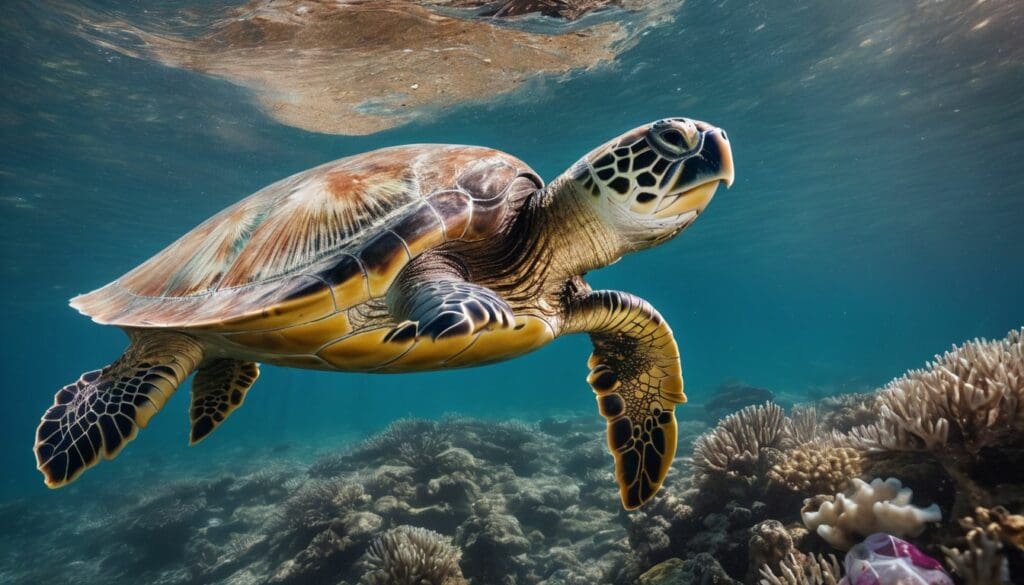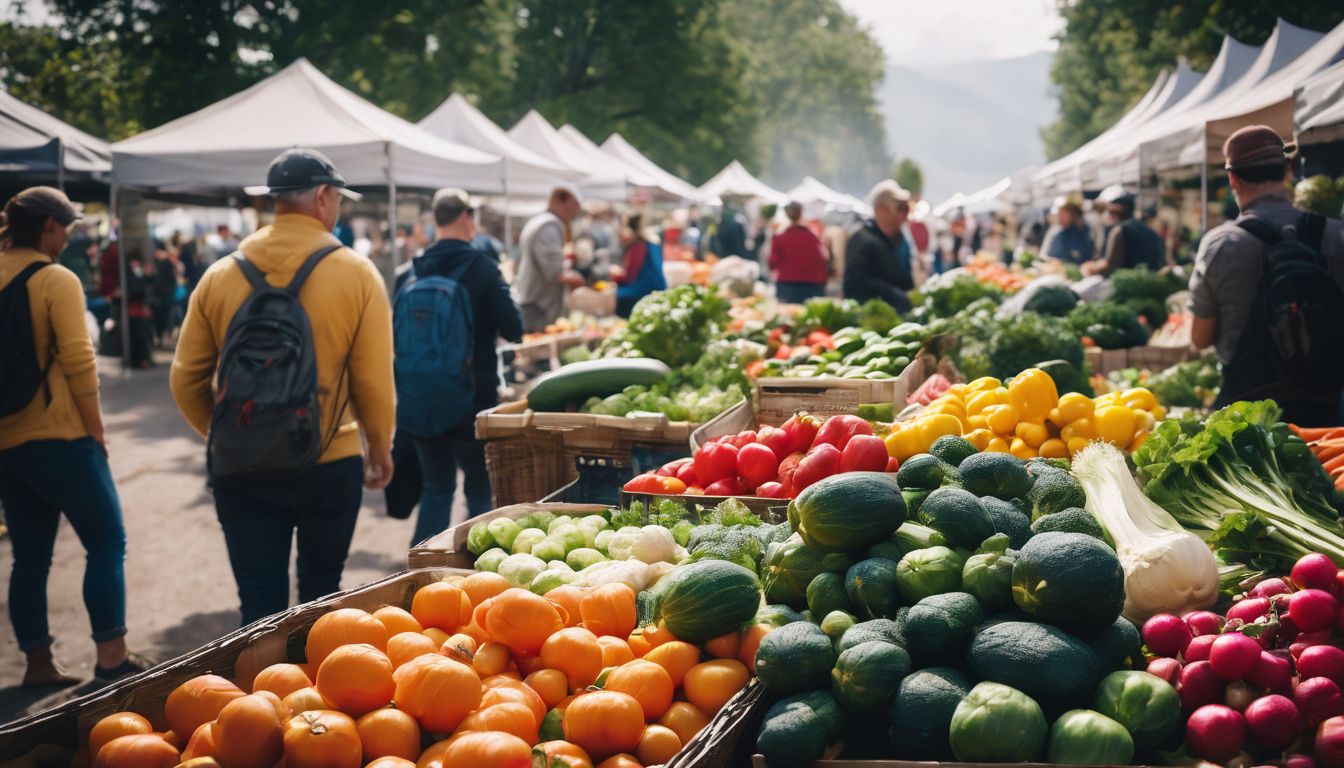We’ve all witnessed the rather sad sight of plastic bags taking unwelcome residence in our trees and bottles strewn across once-pristine beaches. It’s a scene that sits uneasily with many of us, as we ponder over the mountains of single-use plastics suffocating our natural world – it’s alarming to think that an entire lorry-load of plastic is dumped into our oceans every sixty seconds.
Our forthcoming article promises to delve into why this issue is more than just an eyesore; it has serious ramifications for the environment we hold dear. We’ll also share some hands-on advice on how you can be part of a positive change.
So keep your eyes peeled – together, let’s start making a difference.
Key Takeaways
- Single-use plastics are designed for one-time use and include items like bottles, straws, and plastic bags. They lead to environmental issues because they don’t break down easily and create waste that lasts for centuries.
- Plastics pollution harms wildlife as animals can get entangled in debris or mistakenly ingest it, leading to injury or death. Chemicals from these plastics can also leak into our food and water supply causing health problems for humans.
- Solutions to combat this problem include banning single – use plastics, using reusable alternatives like cloth bags instead of plastic ones, and improving recycling systems so less plastic ends up in landfills or the natural environment.
- Implementing plastic bans helps reduce the production demand for new plastics which rely on fossil fuels. This step also aids in cutting down the volume of waste that needs management.
- Everyone has a role to play; by choosing reusables over disposables, we support sustainability goals, contribute less waste pollution and help protect both our ecosystems and personal health.
Understanding Single-Use Plastics
Single-use plastics are items that are designed to be used once and then thrown away, such as plastic bags, straws, and food packaging. They are a common part of our daily lives and contribute significantly to waste and pollution.
Definition of single-use plastics
Single-use plastics are items we use just once before throwing away. These include plastic bags, straws, coffee stirrers, soda and water bottles, and most food packaging. We encounter them everywhere in our daily lives – from the supermarket to takeaways.
They’re designed for convenience but have long-lasting consequences for our environment.
These plastics often end up as waste after a brief use that might last only a few minutes. Despite their short lifespan in our hands, they can persist in the environment for hundreds of years, leading to serious pollution issues.
As we consider their prevalence around us, let’s explore how these disposables contribute to environmental degradation and impact wildlife and human health.
Their prevalence in our daily lives
Single-use plastics are everywhere – from the disposable water bottle we grab on the go to the plastic bags at the grocery store. It’s hard to escape these convenient but environmentally damaging products.
Plastic straws, utensils, and food packaging also make regular appearances in our daily routines, contributing to a significant amount of waste. These items often end up in landfills or as litter, causing harm to our environment and wildlife.
We encounter single-use plastics so frequently that they have become an integral part of modern life, despite their negative impact on the planet. The convenience they offer has led to massive usage rates, exacerbating issues like pollution and landfill accumulation while perpetuating our reliance on fossil fuels for their production.
How they contribute to waste and pollution
Single-use plastics significantly add to the waste and pollution burden on our environment. These disposable items, such as plastic bags and straws, are used briefly before being thrown away.
They often end up in landfills or as litter, contributing to a vast amount of plastic waste that is challenging to manage effectively. Furthermore, the production process for single-use plastics releases harmful greenhouse gas emissions into the atmosphere, exacerbating climate change and further polluting our air and waterways.
The extensive use of single-use plastics also leads to an array of environmental issues like microplastic pollution in oceans and toxic air pollution caused by their incineration. This widespread reliance on throwaway plastics disrupts ecosystems, poses health risks for humans, and impacts wildlife negatively through entanglement or ingestion.
Environmental and Health Impacts of Single-Use Plastics
Single-use plastics contribute to pollution of land, air, and water, impacting both wildlife and ecosystems. Additionally, they pose health risks for humans due to the release of toxic chemicals when breaking down.
Pollution of land, air, and water
Single-use plastics contribute to the pollution of land, air, and water. These disposable plastics often end up in landfills, where they release harmful chemicals into the ground. When plastic waste is burned, it releases toxic fumes into the air, contributing to air pollution.
Additionally, single-use plastics that are not properly disposed of can find their way into rivers and oceans, causing water pollution and posing a threat to marine life.
Improper disposal of single-use plastics can lead to environmental degradation by polluting ecosystems on land and in aquatic environments. Populations of wildlife are also impacted as these plastics interfere with their habitats and food sources when they enter natural environments through various means like wind or water currents.
Harm to wildlife and ecosystems
Pollution of land, air, and water devastates wildlife and ecosystems. Plastics entangle marine animals, leading to injury or death due to suffocation or starvation. Birds mistakenly consume plastic pieces, causing internal injuries and blocking their digestive tracts.
Aquatic life also suffers from the harmful effects of plastic pollution, disrupting food chains and impacting biodiversity.
Furthermore, single-use plastics release toxic substances that poison soil and water systems. As these pollutants accumulate in the environment, they pose a threat to various species, including those crucial for maintaining ecological balance.
Health risks for humans
Single-use plastics pose health risks to humans through the release of toxic chemicals. When these plastics break down, harmful substances such as phthalates and bisphenol A can leach into food and water, entering our bodies upon consumption.
These chemicals are known to disrupt hormones and have been linked to various health issues, including reproductive problems, developmental delays in children, and an increased risk of certain cancers.
Additionally, the production and incineration of single-use plastics contribute to air pollution which can exacerbate respiratory conditions like asthma.
Exposure to microplastics – tiny pieces of plastic less than 5mm in size – is also a concern for human health. These particles have been found in drinking water, seafood, and even the air we breathe.
Solutions to Reduce Single-Use Plastic Waste
Implementing plastic bans, encouraging the use of reusable alternatives, and improving recycling systems are effective ways to reduce single-use plastic waste. Click here to learn more about how we can make a positive impact on the environment.
Implementation of plastic bans
To reduce the impact of single-use plastics on the environment, we advocate for implementing plastic bans in our communities. By prohibiting single-use plastics such as bags, straws, and utensils, we can significantly decrease plastic pollution.
These bans promote the use of sustainable alternatives and encourage individuals to adopt eco-friendly habits.
Through plastic bans, we aim to mitigate ocean pollution and protect wildlife from harm caused by ingesting or becoming entangled in plastic waste. Additionally, these initiatives contribute to reducing fossil fuel extraction for plastic production and promote a shift towards environmentally sustainable practices.
Encouraging the use of reusable alternatives
Encouraging the use of reusable alternatives is crucial for reducing single-use plastic waste. Replacing disposable items such as plastic bags, bottles, and straws with durable, long-lasting options like cloth bags, stainless steel bottles, and metal or bamboo straws can significantly decrease the amount of plastic pollution in our environment.
By choosing reusable products, we can actively contribute to managing waste better and safeguarding our ecosystems from the detrimental effects of single-use plastics. Making a conscious effort to opt for sustainable alternatives aligns with environmental sustainability goals and helps combat marine debris and ecosystem disruption associated with single-use plastics.
Promoting awareness about using reusable alternatives empowers individuals to take proactive steps towards mitigating climate crisis impacts caused by excessive consumption of disposable plastics.
Encouraging the adoption of these eco-friendly substitutes not only minimises pollution but also supports wildlife protection efforts against harmful plastic ingestion and entanglement.
Improving recycling systems
To improve recycling systems, we need to invest in better infrastructure and technology. This includes increasing the number of recycling facilities and providing more convenient access for communities to recycle their plastics.
Moreover, educating people on how to properly recycle and creating incentives for businesses to use recycled materials can help increase the effectiveness of recycling efforts.
Additionally, implementing standardised recycling programmes across different regions will ensure consistency and ease in the recycling process. By doing so, we can significantly reduce the amount of single-use plastic waste that ends up in landfills or pollutes our environment, contributing towards a healthier planet for both wildlife and humans.
Conclusion: Why it is important to reduce our use of single-use plastics and how we can make a positive impact.
Reducing single-use plastics is crucial because they pollute our land, air, and water. Wildlife suffering due to plastic waste highlights the urgency. Taking action by using reusable alternatives makes a positive impact.
Implementing plastic bans can prevent further harm to our environment and wildlife. Our efforts today will secure a cleaner, healthier tomorrow for all living beings.
FAQs
1. What impact do single-use plastics have on the environment?
Single-use plastics can cause serious harm to the environment by contributing to pollution and negatively affecting wildlife.
2. How does single-use plastic affect animals?
Animals often mistake single-use plastic for food, which can lead to injury or death, impacting wildlife populations and ecosystems.
3. Is there a move towards banning single-use plastics?
Yes, many places are implementing singleuse plastic bans to reduce pollution and protect the environment.
4. Can we prevent pollution from single-use plastics?
By reducing our use of these plastics and supporting policies for pollution prevention, we can significantly curb their environmental impact.





